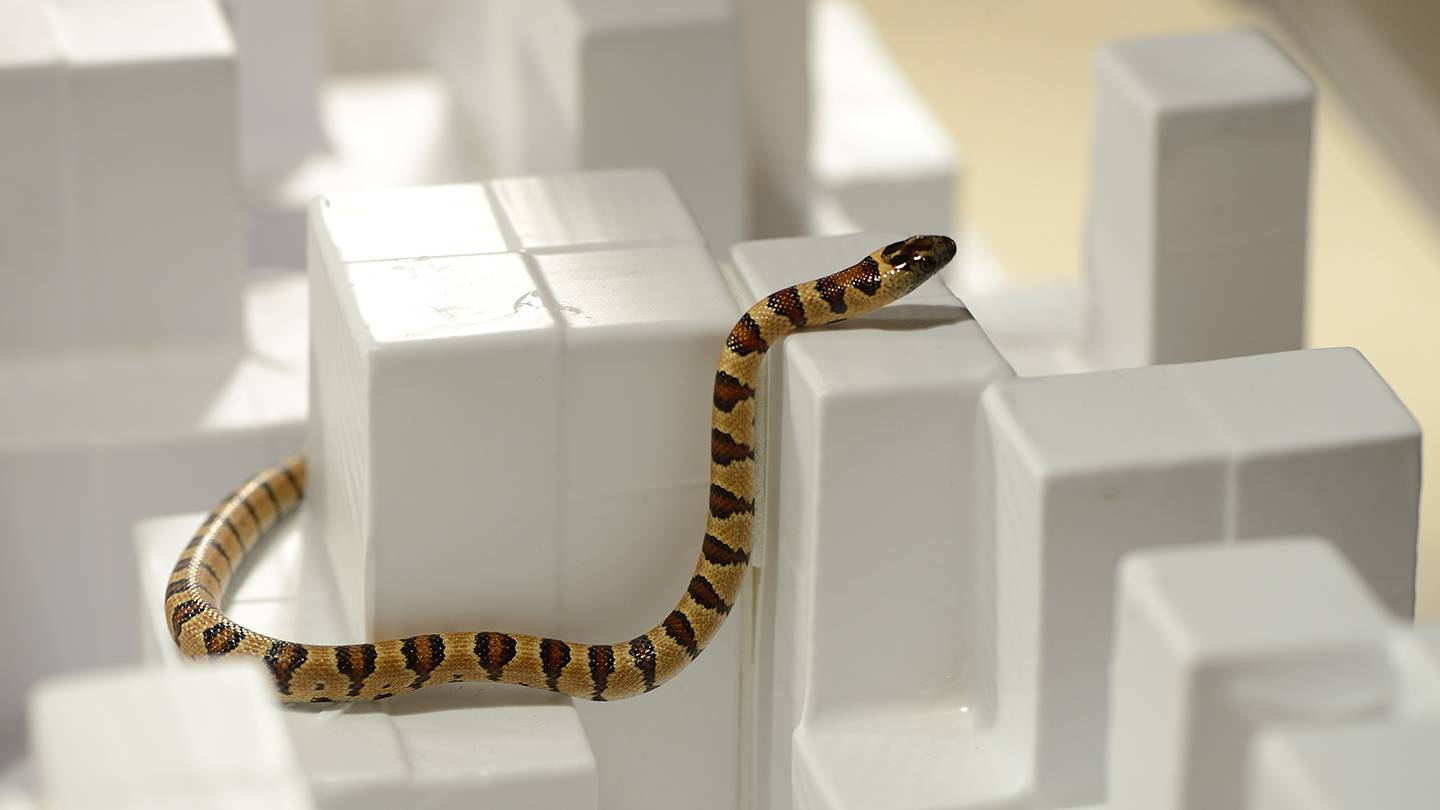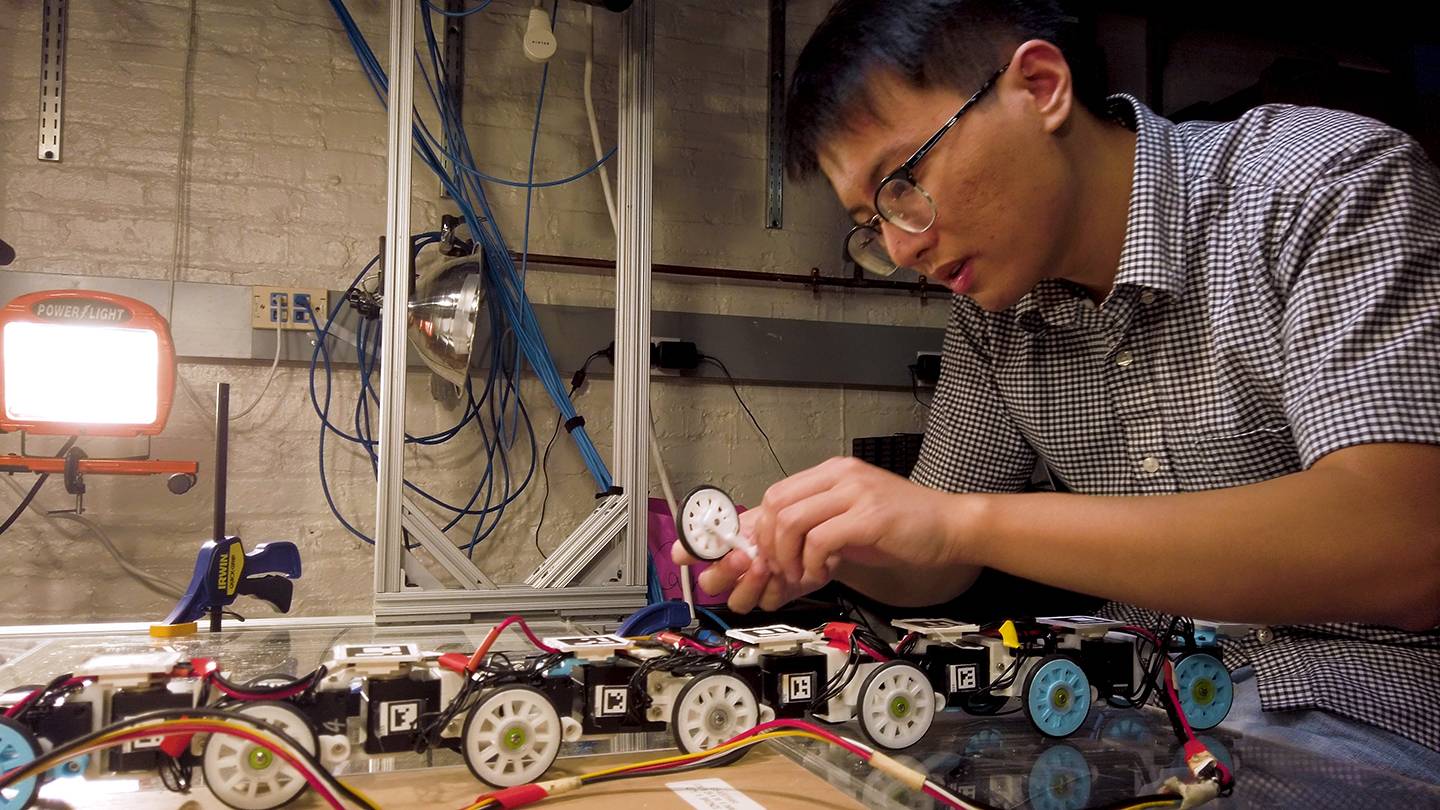2.18.20
Chanapa Tantibanchachai
chanapa@jhu.edu
Office phone 443-997-5056
Cell phone 928-458-9656
Johns Hopkins mechanical engineers design a snake robot based on the climbing technique of the kingsnake that could help advance search-and-rescue technology

Kingsnake, the model for this work.
Snakes live in diverse environments ranging from unbearably hot deserts to lush tropical forests. But regardless of their habitat, they are able to slither up trees, rocks, and shrubbery with ease. By studying how the creatures move, a team of Johns Hopkins engineers have created a snake robot that can nimbly and stably climb large steps.
The team’s new findings, published in Journal of Experimental Biology and Royal Society Open Science, could advance the creation of search and rescue robots that can successfully navigate treacherous terrain.
“We look to these creepy creatures for movement inspiration because they’re already so adept at stably scaling obstacles in their day-to-day lives,” says Chen Li, an assistant professor of mechanical engineering at Johns Hopkins University and the papers’ senior author. “Hopefully our robot can learn how to bob and weave across surfaces just like snakes.”
Snake Robot Locomotion
Previous studies had mainly observed snake movements on flat surfaces, but rarely examined their movement in 3D terrain, except for on trees, says Li. These studies did not account for real-life large obstacles snakes encounter, such as rubble and debris, that a search and rescue robot would similarly have to climb over.
Li’s team first studied how the variable kingsnake, a snake that can commonly be found living in both deserts and pine-oak forests, climbed steps in Li’s Terradynamics Lab. Li’s lab melds the fields of engineering, biology, and physics together to study animal movements for tips and tricks to build more versatile robots.
“These snakes have to regularly travel across boulders and fallen trees; they’re the masters of movement and there’s much we can learn from them,” Li says.
Li and his team ran a series of experiments that changed step height and surface friction to observe how the snakes contorted their bodies in response to these barriers. They found that snakes partitioned their bodies into three movement sections: a front and rear section wriggled back and forth on the horizontal steps like a wave, while the section between remained stiff, hovering just so, to bridge the height of the step. The wriggling portions, they noticed, provided stability to keep the snake from tipping over.

Image credit: Will Kirk / Johns Hopkins University
As the snakes moved onto the step, these three body movement sections traveled down the snake’s body. As more and more of the snake reached the top of the step, its front body section would get longer and its rear section would get shorter while the middle body section remained the height of the step, suspended vertically.
If the steps got taller and more slippery, the snakes would move more slowly and wriggle their front and rear body less to maintain stability.
After analyzing their videos and noting how snakes climbed steps in the lab, Qiyuan Fu, a graduate student in Li’s lab, created a robot to mimic the animals’ movements.
At first, the robot snake had difficulty staying stable on large steps and often wobbled and flipped over or got stuck on the steps. To address these issues, the researchers inserted a suspension system (like that in a vehicle) into each body segment so it could compress against the surface when needed. After this, the snake robot was less wobbly, more stable, and climbed steps as high as 38% of its body length with a nearly 100% success rate.
Compared to snake robots from other studies, Li’s snake robot was speedier and more stable than all but one, and even came close to mimicking the actual snake’s speed. One downside of the added body suspension system, however, was that the robot required more electricity.
“The animal is still far more superior, but these results are promising for the field of robots that can travel across large obstacles,” adds Li.
Next, the team will test and improve the snake robot for even more complex 3-D terrain with more unstructured large obstacles.
See the full article here .

five-ways-keep-your-child-safe-school-shootings
Please help promote STEM in your local schools.
About the Hub
We’ve been doing some thinking — quite a bit, actually — about all the things that go on at Johns Hopkins. Discovering the glue that holds the universe together, for example. Or unraveling the mysteries of Alzheimer’s disease. Or studying butterflies in flight to fine-tune the construction of aerial surveillance robots. Heady stuff, and a lot of it.
In fact, Johns Hopkins does so much, in so many places, that it’s hard to wrap your brain around it all. It’s too big, too disparate, too far-flung.
We created the Hub to be the news center for all this diverse, decentralized activity, a place where you can see what’s new, what’s important, what Johns Hopkins is up to that’s worth sharing. It’s where smart people (like you) can learn about all the smart stuff going on here.
At the Hub, you might read about cutting-edge cancer research or deep-trench diving vehicles or bionic arms. About the psychology of hoarders or the delicate work of restoring ancient manuscripts or the mad motor-skills brilliance of a guy who can solve a Rubik’s Cube in under eight seconds.
There’s no telling what you’ll find here because there’s no way of knowing what Johns Hopkins will do next. But when it happens, this is where you’ll find it.
The Johns Hopkins Universityopened in 1876, with the inauguration of its first president, Daniel Coit Gilman. “What are we aiming at?” Gilman asked in his installation address. “The encouragement of research … and the advancement of individual scholars, who by their excellence will advance the sciences they pursue, and the society where they dwell.”
The mission laid out by Gilman remains the university’s mission today, summed up in a simple but powerful restatement of Gilman’s own words: “Knowledge for the world.”
What Gilman created was a research university, dedicated to advancing both students’ knowledge and the state of human knowledge through research and scholarship. Gilman believed that teaching and research are interdependent, that success in one depends on success in the other. A modern university, he believed, must do both well. The realization of Gilman’s philosophy at Johns Hopkins, and at other institutions that later attracted Johns Hopkins-trained scholars, revolutionized higher education in America, leading to the research university system as it exists today.


